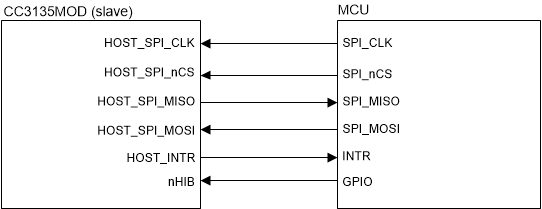JAJSHT5D February 2019 – May 2021 CC3135MOD
PRODUCTION DATA
- 1 特長
- 2 アプリケーション
- 3 概要
- 4 機能ブロック図
- 5 Revision History
- 6 Device Comparison
- 7 Terminal Configuration and Functions
-
8 Specifications
- 8.1 Absolute Maximum Ratings
- 8.2 ESD Ratings
- 8.3 Recommended Operating Conditions
- 8.4 Current Consumption Summary: 2.4 GHz RF Band
- 8.5 Current Consumption Summary: 5 GHz RF Band
- 8.6 TX Power Control for 2.4 GHz Band
- 8.7 TX Power Control for 5 GHz Band
- 8.8 Brownout and Blackout Conditions
- 8.9 Electrical Characteristics for DIO Pins
- 8.10 WLAN Receiver Characteristics
- 8.11 WLAN Transmitter Characteristics
- 8.12 BLE and WLAN Coexistence Requirements
- 8.13 Reset Requirement
- 8.14 Thermal Resistance Characteristics for MOB Package
- 8.15 Timing and Switching Characteristics
- 8.16 External Interfaces
- 9 Detailed Description
- 10Applications, Implementation, and Layout
- 11Environmental Requirements and SMT Specifications
- 12Device and Documentation Support
- 13Mechanical, Packaging, and Orderable Information
8.16.1 SPI Host Interface
The device interfaces to an external host using the SPI. The CC3135MOD module can interrupt the host using the HOST_INTR line to initiate the data transfer over the interface. The SPI host interface can work up to a speed of 20 MHz.
Figure 8-8 shows the SPI host interface.
 Figure 8-8 SPI Host Interface
Figure 8-8 SPI Host Interface
Table 8-9 lists the SPI host interface pins.
Table 8-9 SPI Host Interface
| PIN NAME | DESCRIPTION |
|---|---|
| HOST_SPI_CLK | Clock (up to 20 MHz) from MCU host to CC3135MOD module |
| HOST_SPI_nCS | CS (active low) signal from MCU host to CC3135MOD module |
| HOST_SPI_MOSI | Data from MCU host to CC3135MOD module |
| HOST_INTR | Interrupt from CC3135MOD module to MCU host |
| HOST_SPI_MISO | Data from CC3135MOD module to MCU host |
| nHIB | Active-low signal that commands the CC3135MOD module to enter hibernate mode (lowest power state) |
Figure 8-9 shows the host SPI timing diagram.
 Figure 8-9 Host SPI Timing
Figure 8-9 Host SPI TimingTable 8-10 lists the host SPI timing parameters.
Table 8-10 Host SPI Timing Parameters
| PARAMETER NUMBER | DESCRIPTION | MIN | MAX | UNIT | |
|---|---|---|---|---|---|
| T1 | F | Clock frequency at VBAT = 3.3 V | 20 | MHz | |
| Clock frequency at VBAT = 2.3 V | 12 | ||||
| T2 | tclk | Clock period | 50 | ns | |
| T3 | tLP | Clock low period | 25 | ns | |
| T4 | tHT | Clock high period | 25 | ns | |
| T5 | D | Duty cycle | 45% | 55% | |
| T6 | tIS | RX data setup time | 4 | ns | |
| T7 | tIH | RX data hold time | 4 | ns | |
| T8 | tOD | TX data output delay | 20 | ns | |
| T9 | tOH | TX data hold time | 24 | ns | |